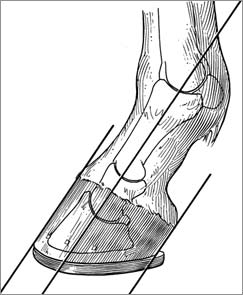 Veterinarians play a role on your team but in the area of hoof care, a skilled, knowledgeable farrier is invaluable. Farriers are experts in the field of hoof care and hoof health. Whether you simply trim your barefoot horses’ hooves or shoe them on a regular schedule, a farrier will be your first line of defense in detecting and correcting problems with this critically important aspect of your horse. A brief note on caring for your farrier: in Germany farriers don’t hold the legs of the horses up, the owner does. This practice highlights the issue of horses behaving badly and inflicting pain on the farrier. If you had to hold up your horse’s legs, would you be able to do so?
Veterinarians play a role on your team but in the area of hoof care, a skilled, knowledgeable farrier is invaluable. Farriers are experts in the field of hoof care and hoof health. Whether you simply trim your barefoot horses’ hooves or shoe them on a regular schedule, a farrier will be your first line of defense in detecting and correcting problems with this critically important aspect of your horse. A brief note on caring for your farrier: in Germany farriers don’t hold the legs of the horses up, the owner does. This practice highlights the issue of horses behaving badly and inflicting pain on the farrier. If you had to hold up your horse’s legs, would you be able to do so?
The horse’s hoof is a complex structure in many ways. The physiology of the hoof is complicated and affected by many things. Good nutrition is crucial to growing good strong hooves, as is genetics. Some horses simply are born with weak, poor hoof wall material and are prone to infections like foot abscesses. By far, most horses have good hooves that simply need routine, timely trimming and care.
In the wild, mustangs wear their hooves down by constantly moving on rough terrain. This isn’t possible on most of our farms today and as a result we have to trim away the excess old growth. If not done in a timely fashion, good conformation can be affected and lameness could be the result. We talk about a good hoof-pastern axis and in simple terms this means that the bones of the lower hoof line up. When they do line up in a straight axis, the physics of the horse limbs allows for a great ability to function as a shock absorber to concussion and minimizes stress and fatigue on the rest of the structures up the leg and body. When they don’t line up, abnormal forces are placed on structures like the navicular bone, impar ligament, and suspensory apparatus. When damage occurs, lameness results and that’s when veterinarians become an active member of the team in this area of care.
Corrective shoeing has traditionally been used to describe shoeing methods that attempt to correct conformational defects. Some of these problems are conformational, but many are the result of poor or infrequent hoof care. This is an area of management that requires your constant attention and when neglected, time is not your friend.